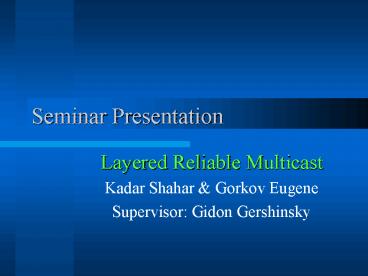Seminar Presentation - PowerPoint PPT Presentation
1 / 12
Title:
Seminar Presentation
Description:
Design and implement a massively scalable multicast protocol. ... Implementing the protocol in most generic way to be undependable on the application. ... – PowerPoint PPT presentation
Number of Views:18
Avg rating:3.0/5.0
Title: Seminar Presentation
1
Seminar Presentation
- Layered Reliable Multicast
- Kadar Shahar Gorkov Eugene
- Supervisor Gidon Gershinsky
2
Project Goals
- Design and implement a massively scalable
multicast protocol. - Provide multi-rate content delivery to large sets
of receivers. - Implement congestion control mechanism for
layered one-way transmission.
3
Project Block Diagram
Sender Application
Multiple Receivers
Our Project
LCT LCC
Multicast IP
Session Log
UDP
4
Project Status
- High level design including class diagram of the
project is completed. - A very simple sender and receiver applications
with very limited functionality were already
implemented (skeleton).
5
Expected Problems
- Emulate network with variable packet loss rate
per receiver. - Implementing the protocol in most generic way to
be undependable on the application.
6
Schedule
- Week by week roadmap
Protocol Implementation
Top Level Application Finalization
Testing Debug
7
Theoretical Background
- The protocol is named Layered Coding Transport
(LCT).
8
Theoretical Background (Cont.)
- Receiver driven Layered Congestion Control (LCC).
- Receivers adjust their reception rate by joining
and leaving groups (layers) with no feedback to
the sender. - Rate adjustment similar to TCP.
- Receiver transparency (receiver sees dedicated
unicast session). - Sender transparency (outgoing rate independent of
receivers number).
9
Theoretical Background (Cont.)
- LCC has two approaches Static and Dynamic.
- Static is simpler.
- Dynamic is designed to overcome IGMP leave
latencies. - Reliability is ensured by Forward Error
Correction algorithm (wont be implemented).
10
Theoretical Background (Cont.)
- Static Layer Scheme
- Each group(layer) has a constant rate
- Each receiver can be in one group at a time
- Receiver moves from group to group according to
packet loss rate - Used when IGMP leave latency is relatively short
11
Theoretical Background (Cont.)
- Dynamic Layer Scheme
- Each layer has a dynamically changing rate
- Each receiver may be in multiple groups at a time
- Receiver joins groups according to packet loss
- Used when IGMP leave latency is long (few
seconds)
12
Dynamic Scheme
Receiver































